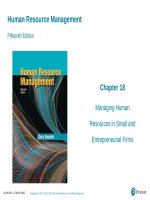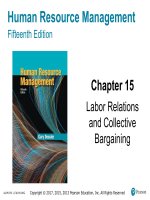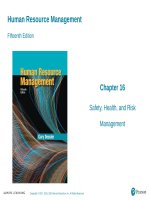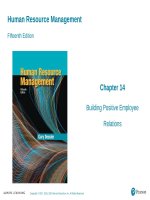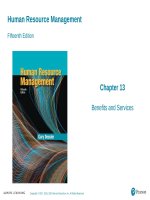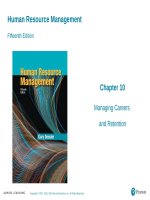Test bank solution of human resource management 15e by gary dessler 2017 chapter 04
Bạn đang xem bản rút gọn của tài liệu. Xem và tải ngay bản đầy đủ của tài liệu tại đây (270.43 KB, 47 trang )
Human Resource Management, 15e (Dessler)
Chapter 4 Job Analysis and the Talent Management Process
1) Which term refers to the holistic, integrated and results and goal-oriented process of planning,
recruiting, selecting, developing, managing, and compensating employees?
A) job analysis
B) HR alignment
C) strategic planning
D) talent management
Answer: D
Explanation: D) Talent management is the holistic, integrated and results and goal-oriented
process of planning, recruiting, selecting, developing, managing, and compensating employees
Talent management means getting the right people (in terms of competencies) in the right jobs, at
the right time, doing their jobs correctly.
Difficulty: Easy
Chapter: 4
Objective: 1
AACSB: Analytical Thinking
Learning Outcome: 4.1 Define talent management and explain why it is important.
2) Connor, a manager at a boat manufacturing firm, takes a talent management approach to his
duties. Which of the following would Connor most likely do?
A) coordinate recruitment and compensation activities
B) use different competencies for recruitment and development
C) rely primarily on applicant testing results for hiring decisions
D) manage employees based on their experience with the organization
Answer: A
Explanation: A) An effective talent management process should integrate the underlying talent
management activities such as recruiting, developing, and compensating employees. The same
competencies should be used for recruiting, training, and appraising. Firms should balance talent
management tasks with testing and proactively manage workers by segmenting them into groups.
Difficulty: Moderate
Chapter: 4
Objective: 1
AACSB: Application of Knowledge
Learning Outcome: 4.1 Define talent management and explain why it is important.
1
Copyright © 2017 Pearson Education, Inc.
3) In an effective talent management system, an employee's performance appraisal would initiate
training and development opportunities.
Answer: TRUE
Explanation: An effective talent management process should integrate the underlying talent
management activities such as recruiting, developing, and compensating employees. For
example, performance appraisals should trigger the required employee training.
Difficulty: Moderate
Chapter: 4
Objective: 1
AACSB: Analytical Thinking
Learning Outcome: 4.1 Define talent management and explain why it is important.
4) Effective talent management focuses on developing employee competencies that align with
strategic goals.
Answer: TRUE
Explanation: Make sure talent management decisions such as staffing, training, and pay are
goal-directed. Managers should always be asking, "What recruiting, testing, or other actions
should I take to produce the employee competencies we need to achieve our strategic goals?"
Difficulty: Moderate
Chapter: 4
Objective: 1
AACSB: Analytical Thinking
Learning Outcome: 4.1 Define talent management and explain why it is important.
5) Which of the following terms refers to the procedure used to determine the duties associated
with job positions and the characteristics of the people to hire for those positions?
A) job description
B) job specification
C) job analysis
D) job context
Answer: C
Explanation: C) Job analysis is the process of determining the duties of a specific job and the
characteristics of the people who would be most appropriate for the job. A job analysis produces
the necessary information to develop job descriptions and job specifications.
Difficulty: Easy
Chapter: 4
Objective: 2
AACSB: Analytical Thinking
Learning Outcome: 4.2 Discuss the process of job analysis, including why it is important.
2
Copyright © 2017 Pearson Education, Inc.
6) The information resulting from a job analysis is used for writing ________.
A) job descriptions
B) corporate objectives
C) personnel questionnaires
D) training requirements
Answer: A
Explanation: A) A job description is a list of what a job entails, and it is derived from a job
analysis. Job analysis is the procedure through which you determine the duties of job positions
and the characteristics of the people that should be hired for the positions.
Difficulty: Easy
Chapter: 4
Objective: 2
AACSB: Analytical Thinking
Learning Outcome: 4.2 Discuss the process of job analysis, including why it is important.
7) All of the following types of information will most likely be collected by a human resources
specialist through a job analysis EXCEPT ________.
A) work activities
B) human behaviors
C) performance standards
D) employee benefits options
Answer: D
Explanation: D) Work activities, human behaviors, performance standards, job context, and
human requirements are the types of information typically collected through a job analysis.
Information gathered through a job analysis is used to develop job descriptions and job
specifications. Managers use job analysis for the purpose of recruitment, compensation, training,
and performance appraisal but not for assessing employee benefits options.
Difficulty: Moderate
Chapter: 4
Objective: 2
AACSB: Analytical Thinking
Learning Outcome: 4.2 Discuss the process of job analysis, including why it is important.
3
Copyright © 2017 Pearson Education, Inc.
8) A manager uses the information in a job analysis for all of the following EXCEPT ________.
A) assessing training requirements
B) complying with FCC regulations
C) determining appropriate compensation
D) providing accurate performance appraisals
Answer: B
Explanation: B) Managers use information gathered from a job analysis for many activities
including providing performance appraisals, recruiting, determining compensation, and assessing
training requirements. Job analysis plays a major role in EEO (Equal Employment Opportunity
Commission) compliance but not with FCC (Federal Communications Commission) regulations.
Difficulty: Moderate
Chapter: 4
Objective: 2
AACSB: Analytical Thinking
Learning Outcome: 4.2 Discuss the process of job analysis, including why it is important.
9) Which of the following most likely depends on a job's required skills, education level, safety
hazards, and degree of responsibility?
A) employee compensation
B) organizational culture
C) annual training requirements
D) OSHA and EEO compliance
Answer: A
Explanation: A) Compensation in the form of salaries and bonuses greatly depends upon a job's
required skills, education level, safety hazards, and level of responsibility. Managers use the job
analysis to determine the relative worth of a specific job and the most appropriate compensation
for an employee.
Difficulty: Moderate
Chapter: 4
Objective: 2
AACSB: Analytical Thinking
Learning Outcome: 4.2 Discuss the process of job analysis, including why it is important.
4
Copyright © 2017 Pearson Education, Inc.
10) In order for Hollis Construction to be in full compliance with the Americans with Disabilities
Act, the manager needs a ________ for each position to validate all human resource activities.
A) performance appraisal
B) compensation schedule
C) workflow system
D) job analysis
Answer: D
Explanation: D) A job analysis is needed for each job at a firm to ensure compliance with the
EEOC. According to the U.S. Federal Agencies' Uniform Guidelines on Employee Selection, a
job analysis is needed to validate all major human resource activities. A firm that is in
compliance with the Americans with Disabilities Act, for example, should know the essential job
functions of each job which requires a job analysis.
Difficulty: Moderate
Chapter: 4
Objective: 2
AACSB: Application of Knowledge
Learning Outcome: 4.2 Discuss the process of job analysis, including why it is important.
11) Allison, a manager at a large clothing retail store, needs to determine essential duties that
have not been assigned to specific employees. Which of the following would most likely provide
Allison with this information?
A) work activities
B) job context
C) job analysis
D) performance standards
Answer: C
Explanation: C) Job analysis can help reveal duties that need to be assigned to a specific
employee. Work activities, performance standards, and job context are the types of information
that are provided through a job analysis.
Difficulty: Moderate
Chapter: 4
Objective: 2
AACSB: Application of Knowledge
Learning Outcome: 4.2 Discuss the process of job analysis, including why it is important.
5
Copyright © 2017 Pearson Education, Inc.
12) The ________ lists a job's specific duties as well as the skills and training needed to perform
a particular job.
A) organization chart
B) job analysis
C) work aid
D) job description
Answer: D
Explanation: D) Job descriptions list the specific duties, skills, and training related to a
particular job. Organization charts show the distribution of work within a company but not
specific duties. A job description is created after a job analysis has been performed.
Difficulty: Easy
Chapter: 4
Objective: 2
AACSB: Analytical Thinking
Learning Outcome: 4.2 Discuss the process of job analysis, including why it is important.
13) Jennifer, a manager at an engineering firm, has been assigned the task of conducting a job
analysis. What should be Jennifer's first step in the process?
A) deciding how the gathered information will be used
B) collecting data on job activities and working conditions
C) selecting representative job positions to assess
D) reviewing relevant background information
Answer: A
Explanation: A) The first step in performing a job analysis is deciding how the job analysis will
be used because this determines the data that will be collected and how it will be collected.
Collecting data, selecting which job positions to analyze, reviewing background information like
organization charts and process charts, and writing job descriptions are additional steps in the job
analysis process.
Difficulty: Moderate
Chapter: 4
Objective: 2
AACSB: Application of Knowledge
Learning Outcome: 4.2 Discuss the process of job analysis, including why it is important.
6
Copyright © 2017 Pearson Education, Inc.
14) Which of the following data collection techniques would be most useful when writing a job
description for a software engineer?
A) distributing position analysis questionnaires
B) interviewing employees
C) analyzing organization charts
D) developing a job process chart
Answer: B
Explanation: B) Interviewing employees to determine what the job entails is an effective method
of collecting data for writing a job description. Position analysis questionnaires are useful for
compensation purposes rather than for writing job descriptions.
Difficulty: Moderate
Chapter: 4
Objective: 2
AACSB: Application of Knowledge
Learning Outcome: 4.2 Discuss the process of job analysis, including why it is important.
15) Which of the following is a written statement that describes the activities, responsibilities,
working conditions, and supervisory responsibilities of a job?
A) job specification
B) job analysis
C) job description
D) job context
Answer: C
Explanation: C) A job description is a written list of a job's duties, responsibilities, reporting
relationships, working conditions, and supervisory responsibilities, and it is the result of a job
analysis.
Difficulty: Easy
Chapter: 4
Objective: 2
AACSB: Analytical Thinking
Learning Outcome: 4.2 Discuss the process of job analysis, including why it is important.
16) Which of the following refers to the human requirements needed for a job, such as education,
skills, and personality?
A) job specifications
B) job analysis
C) job placement
D) job descriptions
Answer: A
Explanation: A) Job specifications are the human requirements needed for a particular job like
education, skills, and personality.
Difficulty: Easy
Chapter: 4
Objective: 2
AACSB: Analytical Thinking
Learning Outcome: 4.2 Discuss the process of job analysis, including why it is important.
7
Copyright © 2017 Pearson Education, Inc.
17) All of the following requirements are typically addressed in job specifications EXCEPT
________.
A) desired personality traits
B) required education levels
C) necessary experience
D) working conditions
Answer: D
Explanation: D) Working conditions, responsibilities, and job duties are addressed in a job
description rather than the job specifications. Job specifications focus on the human requirements
for a job, such as personality, education, skills, and experience.
Difficulty: Moderate
Chapter: 4
Objective: 2
AACSB: Analytical Thinking
Learning Outcome: 4.2 Discuss the process of job analysis, including why it is important.
18) Which of the following indicates the division of work within a firm and the lines of authority
and communication?
A) process chart
B) employee matrix
C) organization chart
D) corporate overview
Answer: C
Explanation: C) Organization charts show the organization-wide division of work with titles of
each position and interconnecting lines that show who reports to and communicates with whom.
Difficulty: Easy
Chapter: 4
Objective: 2
AACSB: Analytical Thinking
Learning Outcome: 4.2 Discuss the process of job analysis, including why it is important.
19) A(n) ________ shows the flow of inputs to and outputs from a job being analyzed.
A) organization chart
B) process chart
C) job analysis
D) job description
Answer: B
Explanation: B) A process chart is a work-flow chart that shows the flow of inputs to and
outputs from a particular job. In the second step of performing a job analysis, background
information such as process charts, organization charts, and job descriptions are reviewed.
Difficulty: Easy
Chapter: 4
Objective: 2
AACSB: Analytical Thinking
Learning Outcome: 4.2 Discuss the process of job analysis, including why it is important.
8
Copyright © 2017 Pearson Education, Inc.
20) A workflow analyst would most likely focus on which of the following?
A) methods used by the firm to accomplish tasks
B) behaviors needed to complete specific work
C) a single, identifiable work process
D) a quantifiable worker skill
Answer: C
Explanation: C) Workflow analysis is a detailed study of the flow of work from job to job in a
work process. Usually, the analyst focuses on one identifiable work process, rather than on how
the company gets all its work done.
Difficulty: Moderate
Chapter: 4
Objective: 2
AACSB: Analytical Thinking
Learning Outcome: 4.2 Discuss the process of job analysis, including why it is important.
21) Which of the following is an example of business process reengineering?
A) using computerized systems to combine separate tasks
B) creating a visual chart for work flow procedures
C) assigning additional activities to new employees
D) developing employee skills and behaviors
Answer: A
Explanation: A) Business process reengineering means redesigning business processes, usually
by combining steps so that small multi-function process teams using information technology to
do the jobs formerly done by a sequence of departments.
Difficulty: Moderate
Chapter: 4
Objective: 2
AACSB: Analytical Thinking
Learning Outcome: 4.2 Discuss the process of job analysis, including why it is important.
22) During the job analysis process, it is important to ________ before collecting data about
specific job duties and working conditions.
A) test job questionnaires on a small group of workers
B) confirm the job activity list with employees
C) select a sample of similar jobs to analyze
D) assemble the job specifications list
Answer: C
Explanation: C) The third step of the job analysis process involves selecting representative
positions to analyze. If there are too many similar jobs in a firm, it is best to select a
representative sample. After representative positions have been chosen, analysis of the job can
occur, which may include interviewing employees or using questionnaires. Job specifications are
not developed until the final step of the job analysis process.
Difficulty: Hard
Chapter: 4
Objective: 2
AACSB: Analytical Thinking
Learning Outcome: 4.2 Discuss the process of job analysis, including why it is important.
9
Copyright © 2017 Pearson Education, Inc.
23) The fourth step in conducting a job analysis most likely involves collecting data about all of
the following EXCEPT ________.
A) required employee abilities
B) typical working conditions
C) employee turnover rates
D) specific job activities
Answer: C
Explanation: C) The fourth step in analyzing a job requires collecting data about job activities,
required employee behaviors, working conditions, and human traits and abilities needed to
perform the job. Interviews, questionnaires, and observations are the most popular methods for
gathering data. It is unlikely that data regarding employee turnover rates would be gathered
during a job analysis.
Difficulty: Moderate
Chapter: 4
Objective: 2
AACSB: Analytical Thinking
Learning Outcome: 4.2 Discuss the process of job analysis, including why it is important.
24) While performing the fifth step of a job analysis, it is essential to confirm the validity of
collected data with the ________.
A) EEOC representative
B) HR manager
C) legal department
D) worker
Answer: D
Explanation: D) According to the fifth step of a job analysis, collected data should be confirmed
with the worker performing the job and his/her immediate supervisor. Although HR managers
play a role in the job analysis process by observing workers, it is the worker and his/her
immediate supervisor that provide direct knowledge of the duties involved in a specific job.
Difficulty: Moderate
Chapter: 4
Objective: 2
AACSB: Analytical Thinking
Learning Outcome: 4.2 Discuss the process of job analysis, including why it is important.
10
Copyright © 2017 Pearson Education, Inc.
25) During the job analysis process, the primary purpose of having workers review and modify
data collected about their current positions is to ________.
A) confirm that the information is correct and complete
B) provide a legal benchmark for employer lawsuits
C) encourage employees to seek additional job training
D) validate the job specification list provided by HR
Answer: A
Explanation: A) Allowing employees to review and modify the information collected about their
current positions provides the opportunity to confirm that the data is correct and complete, which
may help gain employee acceptance of the job analysis data and conclusions. Job specifications
and job descriptions are created after employees review the collected data.
Difficulty: Hard
Chapter: 4
Objective: 2
AACSB: Analytical Thinking
Learning Outcome: 4.2 Discuss the process of job analysis, including why it is important.
26) What is the final step in conducting a job analysis?
A) writing a job description and job specifications
B) validating all of the collected job data
C) collecting data on specific job activities
D) reviewing relevant background information
Answer: A
Explanation: A) The final step in the job analysis process involves developing a job description
and job specifications, which are the two tangible products of a job analysis. This step occurs
after job data has been collected and validated, and background information has been reviewed.
Difficulty: Moderate
Chapter: 4
Objective: 2
AACSB: Analytical Thinking
Learning Outcome: 4.2 Discuss the process of job analysis, including why it is important.
11
Copyright © 2017 Pearson Education, Inc.
27) Murray, Inc. emphasizes a desire for detail-oriented, motivated employees with strong social
skills as indicated in the firm's job ________.
A) specifications
B) analysis
C) reports
D) descriptions
Answer: A
Explanation: A) Job specifications summarize the personal qualities, traits, skills, and
background required for getting a job done. Murray, Inc. wants detail-oriented, motivated
employees, which would be described in the firm's job specifications. Job descriptions address
the activities and responsibilities of a job. Both job descriptions and job specifications are
products of a job analysis.
Difficulty: Moderate
Chapter: 4
Objective: 2
AACSB: Application of Knowledge
Learning Outcome: 4.2 Discuss the process of job analysis, including why it is important.
28) The primary drawback of performing a job analysis regards the ________.
A) unverifiable data a job analysis typically provides
B) certification required to conduct a job analysis
C) amount of time a job analysis takes to complete
D) redundant information gathered during a job analysis
Answer: C
Explanation: C) Conducting a job analysis can be time-consuming because it may take days to
interview multiple employees and their managers, which is why an abbreviated version is often
used by managers. The information gathered through a job analysis is typically verifiable and
useful, and the main cost is time rather than money.
Difficulty: Hard
Chapter: 4
Objective: 2
AACSB: Analytical Thinking
Learning Outcome: 4.2 Discuss the process of job analysis, including why it is important.
12
Copyright © 2017 Pearson Education, Inc.
29) Job ________ means assigning workers additional same-level activities.
A) enrichment
B) assignment
C) enlargement
D) rotation
Answer: C
Explanation: C) Job enlargement refers to assigning workers additional same-level activities.
For example, a worker who previously only bolted the seat to the legs of a chair might attach the
back as well.
Difficulty: Easy
Chapter: 4
Objective: 2
AACSB: Analytical Thinking
Learning Outcome: 4.2 Discuss the process of job analysis, including why it is important.
30) Which of the following terms refers to systematically moving workers from one job to
another?
A) job rotation
B) job enrichment
C) job enlargement
D) job adjustment
Answer: A
Explanation: A) Job rotation refers to systematically moving workers from one job to another.
Difficulty: Easy
Chapter: 4
Objective: 2
AACSB: Analytical Thinking
Learning Outcome: 4.2 Discuss the process of job analysis, including why it is important.
31) Which of the following terms refers to redesigning jobs in a way that increases the
opportunities for the worker to experience feelings of responsibility, achievement, growth, and
recognition?
A) job rotation
B) job enrichment
C) job reengineering
D) job enlargement
Answer: B
Explanation: B) Job enrichment refers to redesigning jobs in a way that increases the
opportunities for the worker to experience feelings of responsibility, achievement, growth, and
recognition. Job enrichment is considered by some experts as the best way to motivate workers
through worker empowerment.
Difficulty: Easy
Chapter: 4
Objective: 2
AACSB: Analytical Thinking
Learning Outcome: 4.2 Discuss the process of job analysis, including why it is important.
13
Copyright © 2017 Pearson Education, Inc.
32) Who argued that the best way to motivate workers is to build opportunities for challenge and
achievement into their jobs via job enrichment?
A) Adam Smith
B) Frederick Taylor
C) Frederick Herzberg
D) Abraham Maslow
Answer: C
Explanation: C) Psychologist Frederick Herzberg argued that the best way to motivate workers
is to build opportunities for challenge and achievement into their jobs via job enrichment. Job
enrichment means redesigning jobs in a way that increases the opportunities for the worker to
experience feelings of responsibility, achievement, growth, and recognition.
Difficulty: Moderate
Chapter: 4
Objective: 2
AACSB: Analytical Thinking
Learning Outcome: 4.2 Discuss the process of job analysis, including why it is important.
33) Jack is an employee at a Best Western Hotel. Some weeks he works with the catering group,
and other weeks he assists the reservations clerk or the parking attendant. This is an example of
________.
A) job enlargement
B) job rotation
C) job enrichment
D) job specialization
Answer: B
Explanation: B) Job rotation refers to systematically moving workers from one job to another, so
when Jack moves from department to department he is participating in job rotation.
Difficulty: Easy
Chapter: 4
Objective: 2
AACSB: Application of Knowledge
Learning Outcome: 4.2 Discuss the process of job analysis, including why it is important.
14
Copyright © 2017 Pearson Education, Inc.
34) The rethinking and redesign of business processes to achieve dramatic improvements in
performance is called ________.
A) job redesign
B) reengineering
C) process engineering
D) job enlargement
Answer: B
Explanation: B) Reengineering, or business process reengineering, refers to redesigning a
business process so that small multidisciplinary self-managing teams complete a task together.
This differs from the typical business process which is similar to a relay race where one person
completes a step and then passes the task to another person.
Difficulty: Easy
Chapter: 4
Objective: 2
AACSB: Analytical Thinking
Learning Outcome: 4.2 Discuss the process of job analysis, including why it is important.
35) The information gathered during a job analysis is primarily used to ensure that firms are in
compliance with the EEO, OSHA, and all state governments.
Answer: FALSE
Explanation: The primary use for information gathered in a job analysis is writing job
descriptions and job specifications. Although job analysis is required for EEO compliance, job
analysis is not required by the Occupational Safety and Health Administration or all state
governments.
Difficulty: Easy
Chapter: 4
Objective: 2
AACSB: Analytical Thinking
Learning Outcome: 4.2 Discuss the process of job analysis, including why it is important.
36) Organization charts show the division of work throughout the organization, how a job relates
to others, and where a job fits in the organization.
Answer: TRUE
Explanation: An organization chart shows the organization-wide distribution of work, with titles
of each position and interconnecting lines that show who reports to and communicates with
whom.
Difficulty: Easy
Chapter: 4
Objective: 2
AACSB: Analytical Thinking
Learning Outcome: 4.2 Discuss the process of job analysis, including why it is important.
15
Copyright © 2017 Pearson Education, Inc.
37) A process chart provides relevant background information during the job analysis process by
indicating job titles and lines of communication.
Answer: FALSE
Explanation: A process chart shows the flow of inputs to and outputs from a job being analyzed.
Difficulty: Moderate
Chapter: 4
Objective: 2
AACSB: Analytical Thinking
Learning Outcome: 4.2 Discuss the process of job analysis, including why it is important.
38) After identifying a business process to redesign, the next step in business process
reengineering is measuring the performance of the existing process.
Answer: TRUE
Explanation: Business process reengineering means redesigning business processes, usually by
combining steps so that small multi-function process teams using information technology do the
jobs formerly done by a sequence of departments. After choosing the business process to
redesign, the analyst needs to assess the performance of the existing process for the purpose of
identifying improvement possibilities.
Difficulty: Moderate
Chapter: 4
Objective: 2
AACSB: Analytical Thinking
Learning Outcome: 4.2 Discuss the process of job analysis, including why it is important.
39) Conducting the job analysis is the sole responsibility of the HR specialist.
Answer: FALSE
Explanation: Job analysis should be a joint effort by a human resources specialist, the worker,
and the worker's supervisor. The HR manager may observe the worker and then have the
supervisor and worker fill out questionnaires.
Difficulty: Moderate
Chapter: 4
Objective: 2
AACSB: Analytical Thinking
Learning Outcome: 4.2 Discuss the process of job analysis, including why it is important.
40) If a manager wants to know "should a job even exist," a workflow analysis should be
performed.
Answer: TRUE
Explanation: A workflow analysis does answer questions like "should a job even exist," because
it is a detailed study of the flow of work from job to job in a work process.
Difficulty: Moderate
Chapter: 4
Objective: 2
AACSB: Analytical Thinking
Learning Outcome: 4.2 Discuss the process of job analysis, including why it is important.
16
Copyright © 2017 Pearson Education, Inc.
41) Job enlargement refers to redesigning jobs in a way that increases responsibility and
achievement.
Answer: FALSE
Explanation: Job enlargement refers to assigning workers additional same-level activities. For
example, a worker who previously only bolted the seat to the legs of a chair might attach the
back as well. Job enrichment refers to redesigning jobs to increase responsibility and
achievement.
Difficulty: Easy
Chapter: 4
Objective: 2
AACSB: Analytical Thinking
Learning Outcome: 4.2 Discuss the process of job analysis, including why it is important.
42) In reengineered business processes, workers tend to become collectively responsible for
overall results rather than individually responsible for just their own tasks.
Answer: TRUE
Explanation: Business process reengineering involves redesigning a business process so that
small multidisciplinary, self-managing teams get a task done together, all at once. Such a system
leads to workers becoming collectively responsible for overall results rather than merely focused
on their individual tasks.
Difficulty: Moderate
Chapter: 4
Objective: 2
AACSB: Analytical Thinking
Learning Outcome: 4.2 Discuss the process of job analysis, including why it is important.
43) How does job analysis support human resource management activities? Briefly describe one
of the methods commonly used for gathering job analysis data.
Answer: Job analysis provides information for recruitment and selection by laying out what the
job entails and what human characteristics are required to perform these activities. This
information helps management decide what sort of people to recruit and hire. Job analysis
information is also crucial for estimating the value of each job and its appropriate compensation.
A performance appraisal compares each employee's actual performance with his or her
performance standards. Managers use job analysis to determine the job's specific activities and
performance standards.
Job analysis interviews are one of the most commonly used methods for gathering job analysis
data. They range from completely unstructured interviews to highly structured ones containing
hundreds of specific items to check off. Managers may conduct individual interviews with each
employee, group interviews with groups of employees who have the same job, and/or supervisor
interviews with one or more supervisors who know the job.
Difficulty: Hard
Chapter: 4
Objective: 2
AACSB: Analytical Thinking
Learning Outcome: 4.2 Discuss the process of job analysis, including why it is important.
17
Copyright © 2017 Pearson Education, Inc.
44) What are the steps involved in the job analysis process? Briefly discuss the methods
available for collecting job analysis information.
Answer: There are six steps in doing a job analysis. Step 1: Decide How You Will Use the
Information. Step 2: Review Relevant Background Information about the Job, Such as
Organization Charts and Process Charts. Step 3: Select Representative Positions.
Step 4: Actually Analyze the Job. Step 5: Verify the Job Analysis Information with the
Worker Performing the Job and with His or Her Immediate Supervisor. Step 6: Develop a
Job Description and Job Specification.
There are various ways (interviews or questionnaires, for instance) to collect information on a
job's duties, responsibilities, and activities. In practice, you could use any one of them, or
combine several. The basic rule is to use those that best fit your purpose. Thus, an interview
might be best for creating a list of job duties and job descriptions. The more quantitative position
analysis questionnaire may be best for quantifying each job's relative worth for pay purposes.
Interviews, questionnaires, observations, and diary/logs are the most popular methods for
gathering job analysis data. They all provide realistic information about what job incumbents
actually do.
Difficulty: Hard
Chapter: 4
Objective: 2
AACSB: Analytical Thinking
Learning Outcome: 4.2 Discuss the process of job analysis, including why it is important.
45) What is the difference between job enlargement, job rotation, and job enrichment?
Answer: Job enlargement means assigning workers additional same-level activities. Thus, the
worker who previously only bolted the seat to the legs might attach the back as well. Job rotation
means systematically moving workers from one job to another. Psychologist Frederick Herzberg
argued that the best way to motivate workers is through job enrichment. Job enrichment means
redesigning jobs in a way that increases the opportunities for the worker to experience feelings of
responsibility, achievement, growth, and recognition. It does this by empowering the worker—
for instance, by giving the worker the skills and authority to inspect the work, instead of having
supervisors do that. Herzberg said empowered employees would do their jobs well because they
wanted to, and quality and productivity would rise.
Difficulty: Moderate
Chapter: 4
Objective: 2
AACSB: Analytical Thinking
Learning Outcome: 4.2 Discuss the process of job analysis, including why it is important.
18
Copyright © 2017 Pearson Education, Inc.
46) Which of the following guidelines is most likely recommended to managers conducting a job
analysis?
A) Use one tool for gathering information to maintain the validity of the final results.
B) Rely on the human resource manager to complete questionnaires and verify data.
C) Conduct group interviews without supervisors present to ensure accuracy.
D) Ensure that the questions and the process are clarified to employees.
Answer: D
Explanation: D) Managers should make sure that the job analysis process and the questions
asked to employees are clear. Several tools should be used to gather information rather than only
one, and employees and supervisors typically complete questionnaires rather than HR managers.
Supervisors should be included in group interviews.
Difficulty: Hard
Chapter: 4
Objective: 3
AACSB: Analytical Thinking
Learning Outcome: 4.3 Explain how to use at least three methods of collecting job analysis
information, including interviews, questionnaires, and observation.
47) Which method for collecting job analysis information is considered best for quantifying the
relative worth of a job for compensation purposes?
A) electronic log
B) worker diary
C) observation
D) position analysis questionnaire
Answer: D
Explanation: D) The position analysis questionnaire's strength is in assigning jobs to job classes
for pay purposes. With ratings for each job's decision-making, skilled activity, physical activity,
vehicle/equipment operation, and information-processing characteristics, you can quantitatively
compare jobs relative to one another and then classify jobs for pay purposes.
Difficulty: Moderate
Chapter: 4
Objective: 3
AACSB: Analytical Thinking
Learning Outcome: 4.3 Explain how to use at least three methods of collecting job analysis
information, including interviews, questionnaires, and observation.
19
Copyright © 2017 Pearson Education, Inc.
48) Jerome, a manager at an electronics company, needs to gather job analysis information from
a large number of employees who perform similar work. Which of the following would be most
appropriate for Jerome?
A) observing all employees
B) interviewing the HR manager
C) holding a group interview with a supervisor
D) conducting telephone surveys of all employees
Answer: C
Explanation: C) When a large number of employees perform similar or identical work,
conducting a group interview is a fast way to gather information. In most cases, the workers'
immediate supervisor attends the group session. It would be costly and time consuming to
observe each worker.
Difficulty: Hard
Chapter: 4
Objective: 3
AACSB: Application of Knowledge
Learning Outcome: 4.3 Explain how to use at least three methods of collecting job analysis
information, including interviews, questionnaires, and observation.
49) Which of the following is the primary disadvantage of using interviews to collect job
analysis data?
A) Interviews are a complicated method for collecting information.
B) Employees may exaggerate or minimize some information.
C) Interviews provide only general information about a worker's duties.
D) Interviews may require managers to reveal the job analysis function.
Answer: B
Explanation: B) The primary disadvantage of conducting employee interviews for the purpose
of gathering job analysis data is the distortion of information. Employees may misunderstand the
purpose of the interview and either purposely or mistakenly provide incorrect information.
Interviews are considered a simple method for collecting detailed job information especially
regarding uncommon but important employee activities.
Difficulty: Hard
Chapter: 4
Objective: 3
AACSB: Analytical Thinking
Learning Outcome: 4.3 Explain how to use at least three methods of collecting job analysis
information, including interviews, questionnaires, and observation.
20
Copyright © 2017 Pearson Education, Inc.
50) Interviews for the purpose of collecting job analysis data will most likely address all of the
following topics EXCEPT ________.
A) hazardous conditions
B) primary work duties
C) required education
D) personal hobbies
Answer: D
Explanation: D) Typical questions for job analysis interviews address subjects such as the job's
major duties, hazardous conditions, performance standards, and required experience and
education. It is less likely that an interviewer would ask an employee questions not related
specifically to the job, such as personal questions about the worker's hobbies and free time.
Difficulty: Easy
Chapter: 4
Objective: 3
AACSB: Analytical Thinking
Learning Outcome: 4.3 Explain how to use at least three methods of collecting job analysis
information, including interviews, questionnaires, and observation.
51) Job analysts collecting information through observations and interviews benefit from the use
of a(n) ________ to guide the process and ensure consistency.
A) structured list
B) electronic diary
C) job description
D) organization chart
Answer: A
Explanation: A) A structured list or checklist is useful for guiding an interview or performing a
personal observation. Electronic diaries are completed by the worker and would not be used for
observations or interviews.
Difficulty: Easy
Chapter: 4
Objective: 3
AACSB: Analytical Thinking
Learning Outcome: 4.3 Explain how to use at least three methods of collecting job analysis
information, including interviews, questionnaires, and observation.
21
Copyright © 2017 Pearson Education, Inc.
52) Which of the following is the primary disadvantage of using questionnaires to gather job
analysis information?
A) Questionnaires are the most expensive method of collecting data.
B) Supervisors are required to verify all collected questionnaire data.
C) Questionnaires are too open-ended for statistical information.
D) Developing and testing questionnaires is time-consuming.
Answer: D
Explanation: D) The primary drawback of questionnaires is the time required to develop
questionnaires and test them to ensure that workers understand the questions. Questionnaires can
be structured or open-ended, and many are a combination of the two.
Difficulty: Hard
Chapter: 4
Objective: 3
AACSB: Analytical Thinking
Learning Outcome: 4.3 Explain how to use at least three methods of collecting job analysis
information, including interviews, questionnaires, and observation.
53) For which of the following jobs is direct observation NOT a recommended method for
collecting job analysis data?
A) assembly-line worker
B) accounting clerk
C) attorney
D) nurse
Answer: C
Explanation: C) Direct observation is particularly useful when jobs consist mainly of observable
physical activities, such as with nurses, accounting clerks, assembly-line workers, and
salespersons. Observation is less appropriate when a job involves mostly mental activity such as
with lawyers and design engineers.
Difficulty: Moderate
Chapter: 4
Objective: 3
AACSB: Analytical Thinking
Learning Outcome: 4.3 Explain how to use at least three methods of collecting job analysis
information, including interviews, questionnaires, and observation.
22
Copyright © 2017 Pearson Education, Inc.
54) One of the problems with direct observation is ________, which is when workers alter their
normal activities because they are being watched.
A) flexibility
B) falsification
C) reactivity
D) diversion
Answer: C
Explanation: C) Reactivity occurs when a worker changes what he or she normally does because
observation is taking place for the purpose of job analysis. Knowing that they are being watched
may cause some workers to alter their normal work behaviors either on purpose or accidentally.
Difficulty: Easy
Chapter: 4
Objective: 3
AACSB: Analytical Thinking
Learning Outcome: 4.3 Explain how to use at least three methods of collecting job analysis
information, including interviews, questionnaires, and observation.
55) A ________ is the time it takes to complete a job.
A) work cycle
B) work week
C) shift
D) duty
Answer: A
Explanation: A) A work cycle is the time it takes to complete a job, which may be one minute
for an assembly-line worker or weeks for an engineer. Managers collecting data for a job
analysis may observe a worker on the job for a complete work cycle and take notes of the
worker's activities.
Difficulty: Easy
Chapter: 4
Objective: 3
AACSB: Analytical Thinking
Learning Outcome: 4.3 Explain how to use at least three methods of collecting job analysis
information, including interviews, questionnaires, and observation.
23
Copyright © 2017 Pearson Education, Inc.
56) Which data collection method is most frequently used in conjunction with direct
observation?
A) interview
B) questionnaire
C) electronic log
D) survey
Answer: A
Explanation: A) Managers frequently combine direct observation with personal interviews to
gather job analysis information. Often, managers observe the worker for a complete work cycle
to gather as much information as possible, and then they follow up with an interview to gain
clarification. Another option is to observe and interview at the same time by asking the worker
questions as he or she works.
Difficulty: Moderate
Chapter: 4
Objective: 3
AACSB: Analytical Thinking
Learning Outcome: 4.3 Explain how to use at least three methods of collecting job analysis
information, including interviews, questionnaires, and observation.
57) Which of the following requires workers to make daily listings of the activities in which they
engage as well as the amount of time each activity takes?
A) flowchart
B) agenda
C) outline
D) log
Answer: D
Explanation: D) A diary or a log requires workers to make daily listings of the activities in
which they engage as well as the amount of time each activity takes. Diaries and logs can be
useful in the job analysis process because they often produce a complete picture of the job,
especially when used in conjunction with an interview.
Difficulty: Easy
Chapter: 4
Objective: 3
AACSB: Analytical Thinking
Learning Outcome: 4.3 Explain how to use at least three methods of collecting job analysis
information, including interviews, questionnaires, and observation.
24
Copyright © 2017 Pearson Education, Inc.
58) Joaquin records every activity in which he participates at work along with the time it takes
him to complete each activity. Which of the following approaches to job analysis data collection
is most likely being used at Joaquin's workplace?
A) diaries
B) interviews
C) observations
D) questionnaires
Answer: A
Explanation: A) Joaquin has been asked to keep a diary or a log of his work activities. With
diaries and logs, an employee records every activity and the time spent on each in a log, which
provides a complete picture of the job. Diaries and logs are often used in conjunction with
interviews, observations, and questionnaires.
Difficulty: Moderate
Chapter: 4
Objective: 3
AACSB: Application of Knowledge
Learning Outcome: 4.3 Explain how to use at least three methods of collecting job analysis
information, including interviews, questionnaires, and observation.
59) Pocket dictating machines and pagers have replaced traditional diary/log methods in many
firms. Which of the following problems have the modern methods most likely eliminated?
A) work time required to fill out forms and surveys
B) employee forgetfulness regarding daily activities
C) costs associated with copying and filing paperwork
D) employee frustration towards bureaucratic requirements
Answer: B
Explanation: B) Some firms provide employees with pocket dictating machines and pagers to
keep diaries and logs. At random times during the day, the employee is paged. The employee
then dictates what he or she is doing. With this method, employers do not have to rely on
workers to remember what they did hours earlier when they complete their logs at the end of the
day, which was the main problem with paper/pencil diaries.
Difficulty: Hard
Chapter: 4
Objective: 3
AACSB: Analytical Thinking
Learning Outcome: 4.3 Explain how to use at least three methods of collecting job analysis
information, including interviews, questionnaires, and observation.
25
Copyright © 2017 Pearson Education, Inc.

